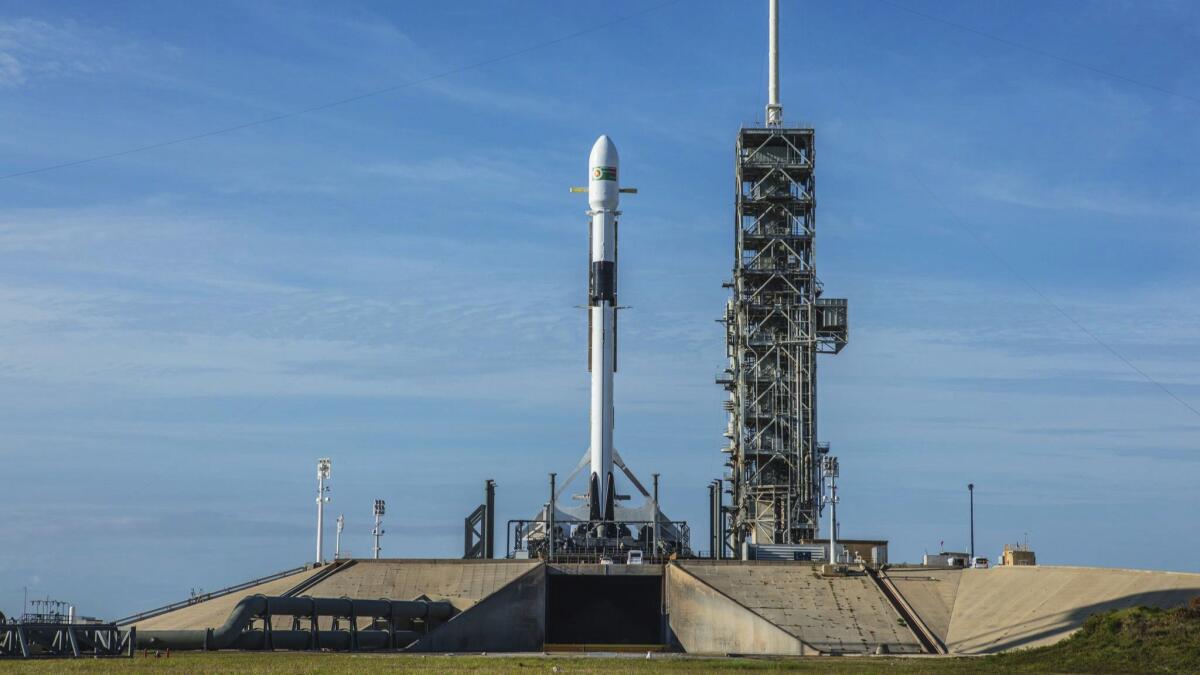SpaceX launches upgraded Falcon 9 rocket and lands first-stage booster

- Share via
SpaceX’s upgraded Falcon 9 rocket made its debut Friday afternoon and the rocket’s first-stage stuck the landing after a previous launch attempt ended in a scrub.
The Hawthorne space company launched Bangladesh’s first geostationary communications satellite Friday at 1:14 p.m. Pacific time from Kennedy Space Center in Florida. SpaceX had intended to launch the satellite Thursday on its newly upgraded Block 5 Falcon 9, but the rocket’s computers initiated an abort with 58 seconds left in the countdown.
About eight minutes after liftoff, the first-stage booster returned to Earth, landing on a floating sea platform. It was SpaceX’s 25th successful booster landing. The satellite deployed about 34 minutes after liftoff.
The changes incorporated into the Block 5 version of the rocket are intended to allow at least 10 reuses of the first-stage booster and improve performance and turnaround time between launches. Reusability is key to SpaceX’s plan to reduce launch costs, and eventually, make its way to Mars.
Some of those changes include upgraded electronics and guidance systems, as well as new thermal protection technology to safeguard against fires in the engine and on the booster’s landing legs, SpaceX Chief Executive Elon Musk said in a Thursday call with reporters.
Block 5 will be the final substantial update to the workhorse Falcon 9. That rocket and the heavy-lift Falcon Heavy will eventually be replaced by SpaceX’s next-generation BFR rocket and spaceship system, which will be built at the Port of Los Angeles.
The latest version of the Falcon 9 will also be used to carry astronauts to the International Space Station and to hoist national security satellites into space, meaning input from NASA and the U.S. military factored heavily into its design and development.
On Thursday, Musk addressed safety concerns about SpaceX’s so-called load-and-go fueling process, in which propellants would be loaded into the rocket while astronauts are onboard the Dragon 2 crew capsule. He said SpaceX could still change the procedure to load propellant first before having astronauts board the capsule and that there were contingency plans to reduce other risks. But he said he thought the issue was “overblown.”
“I don’t think it’s going to be necessary any more than passengers on aircraft need to wait until the aircraft is full of fuel before boarding,” he said.
Twitter: @smasunaga
UPDATES:
2:05 p.m.: This article was updated with the satellite’s deployment.
1:25 p.m.: This article was updated with details of the launch.
This article was originally published at 7:30 a.m.
More to Read
Inside the business of entertainment
The Wide Shot brings you news, analysis and insights on everything from streaming wars to production — and what it all means for the future.
You may occasionally receive promotional content from the Los Angeles Times.









